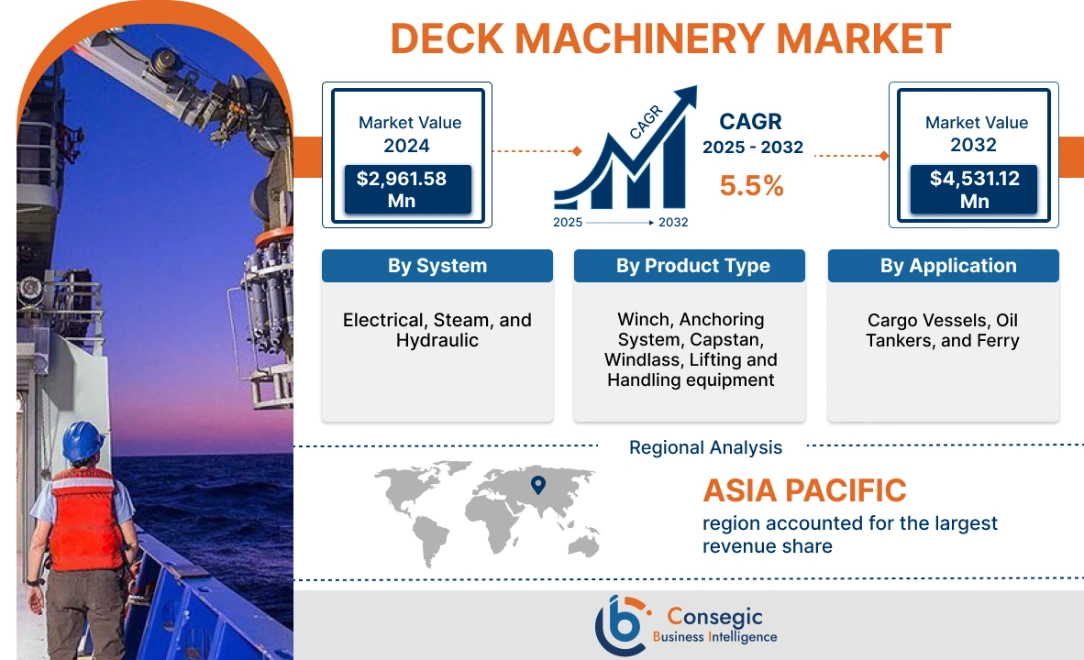Deck Machinery Market Size :
Deck Machinery Market size is estimated to reach over USD 4,531.12 Million by 2032 from a value of USD 2,961.58 Million in 2024, growing at a CAGR of 5.5% from 2025 to 2032.
Deck Machinery Market Scope & Overview :
Deck machinery involves mechanical machinery installed on the ship's deck for boarding, de-boarding, ship docking, and transportation of cargo. The machinery includes anchors, winches, and capstans that allow sailors to operate the ship safely and efficiently. Moreover, they are used to adjust and control the direction of a ship's bow (front) into waves as it moves through the water.
Deck Machinery Market Insights :
Deck Machinery Market Dynamics - (DRO) :
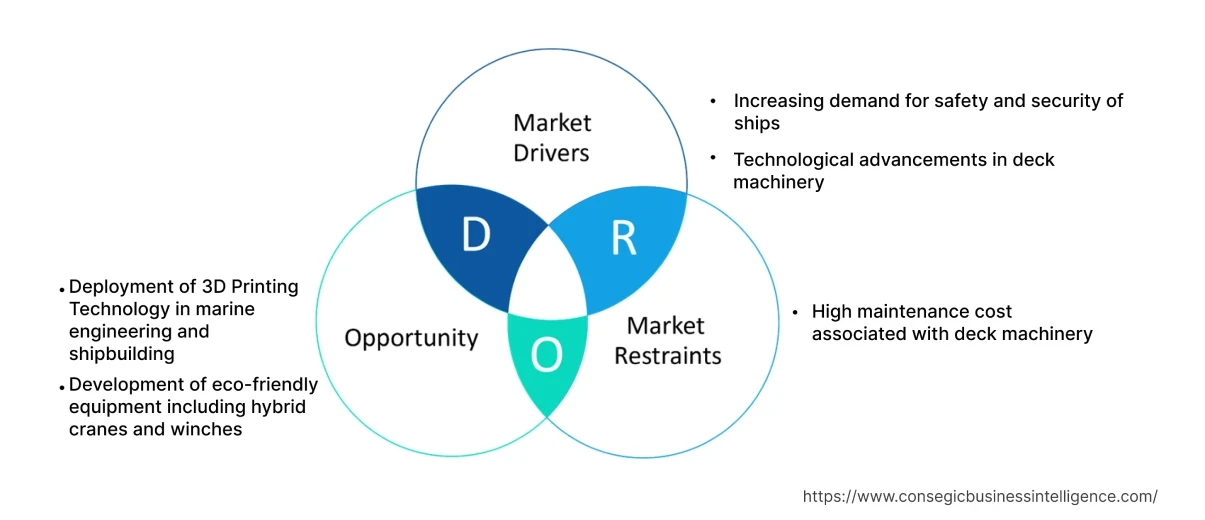
Key Drivers :
Increasing demand for safety and security of ships
The increasing demand for deck machinery for efficient sailing of ships is driving the development of the market. This machinery is used for cargo handling, specifically for loading and unloading cargo in ships. As a result, heavy machinery is required for safe and efficient transportation of cargoes. Further, increasing focus on safety measures has led to the incorporation of advanced machinery with enhanced safety measures. The machinery including wrenches capstans and crane ensures secure lifting and handling of heavy cargo. Moreover, the demand for heavy and efficient deck machines is increasing in order to provide vessel security. Furthermore, automation and remote-control technologies are integrated into these machinery to enhance safety and operational efficiency. Automated winch system is commonly employed for reducing the need for manual intervention thereby minimizing the human interventions. For instance, in April 2021, MacGregor launched the next-generation range of windlass and mooring winches designed to improve safety, reliability and performance. Thus, the growing demand for safety and security of sailing ships is accelerating the requirement of the deck machinery market.
Technological advancements in deck machinery
Continuous advancements in deck machinery systems such as the deployment of Global Positioning System (GPS) and satellite communication systems are driving the requirement of the market. Real-time load and speed sensing technology provides information required to the system's controller to allow the ships to respond during changing dynamic conditions. As a result, the increasing requirement for heavy machinery such as tugs and towing systems capable of handling large cargo vessels in extremely dynamic and variable open-water conditions is driving the requirement of the market. For instance, in February 2021, Hawboldt Industries installed an ABB winch drive with unique inbuilt Active Heave Compensation (AHC) software to provide a safe, efficient and reliable way of sailing ships in roughest sea conditions. Thus, continuous advancements in the technology of deck machinery industry are contributing to the safe and efficient sea transportation systems.
Key Restraints :
High maintenance cost associated with deck machinery
The high maintenance costs associated with deck machinery are restraining the growth of the market. Maintenance costs of these machinery depend upon the type of machinery, frequency of use, and the environmental conditions. Changing environmental conditions are heavily impacting the ships travelling by different sea routes caused by rising sea levels. Moreover, extreme weather condition due to storm surges and extreme waves causes permanent or temporary damage to the machinery equipment boarded on the ship. Furthermore, frequent and mandated maintenance of these machinery adds up to the overall cost of the machinery, thereby restraining the development of the market.
Future Opportunities :
Deployment of 3D Printing Technology in marine engineering and shipbuilding
The deployment of 3D printing technology in marine engineering and shipbuilding is expected to provide deck machinery market opportunities. 3D printing technology offers many advantages including design flexibility, rapid prototyping, and reduced lead time among others. Further, several shipbuilding manufacturers are utilizing Computer-Aided Design (CAD) drawings of ship models to create 3D-printed ship parts. CAD is deployed for the construction and reconstruction of these machinery to improve existing designs with means of retrofits and enhancements methods. Moreover, 3D printing technique provides ease and convenience to the manufacturers to produce machine parts with high accuracy and precision, further expected to drive the development of the deck machinery market during the forecast period.
Development of eco-friendly equipment including hybrid cranes and winches
The development of eco-friendly equipment such as hybrid cranes and winches due to the growing focus on safety and sustainability are expected to provide lucrative opportunities for the market. The increasing focus on safety and sustainability has led to the development of hybrid cranes and winches that have minimal impact on the environment. The deployment of hybrid cranes and winches uses less fuel and produces less emissions in comparison to traditional equipment. Therefore, the deployment of equipment that has minimal environmental impact is expected to drive the market development during the forecast period.
Deck Machinery Market Report Insights :
| Report Attributes | Report Details |
| Study Timeline | 2019-2032 |
| Market Size in 2032 | USD 4,531.12 Million |
| CAGR (2025-2032) | 5.5% |
| Based on the System | Electrical, Steam, and Hydraulic |
| Based on the Product Type | Winch, Anchoring System, Capstan, Windlass, Lifting and Handling equipment |
| Based on the Application | Cargo Vessels, Oil Tankers, and Ferry |
| Based on the Region | North America, Europe, Asia-Pacific, Latin America, and Middle East & Africa |
| Key Players | AMGC, Coastal Marine Equipment, Funz San Industry, Kawasaki Heavy Industries, MacGregor, Marine Equipment Pellegrini, PALFINGER AG, PaR Systems, Rapp Marine, Towimor, TTS Group ASA, Wartsila |
| Geographies Covered | |
| North America | U.S. Canada Mexico |
| Europe | U.K. Germany France Spain Italy Russia Benelux Rest of Europe |
| APAC | China South Korea Japan India Australia ASEAN Rest of Asia-Pacific |
| Middle East and Africa | GCC Turkey South Africa Rest of MEA |
| LATAM | Brazil Argentina Chile Rest of LATAM |
| Report Coverage | Revenue Forecast, Competitive Landscape, Growth Factors, Restraint or Challenges, Opportunities, Environment & Regulatory Landscape, PESTLE Analysis, PORTER Analysis, Key Technology Landscape, Value Chain Analysis, Cost Analysis, and Regional Trends & Forecast |
Deck Machinery Market Segmental Analysis :
Based on the System :
Based on the system, the market is trifurcated into electrical, steam, and hydraulic. The hydraulic deck machinery accounted for the largest revenue share in the year 2024. Hydraulic motors have less internal leak than a gear motor. As a result, hydraulic motors are well-suited for applications that require lower speeds. Moreover, the regulation of speed and positioning of hydraulic motors are adjustable, thus providing ease to operator. Moreover, hydraulic motors provide the ability to accelerate or decelerate the ships more conveniently according to the requirements. Consequently, hydraulic motors have the tendency to withstand harsh environmental conditions, resulting in the deck machinery market growth.
The electric deck machinery segment is expected to witness fastest CAGR growth during the forecast period due to the zero-emission, lesser noise, and lower response time. Electric winches provide superior performance and a greater degree of reliability in comparison to other systems that deploy hydraulic and other sources of energy. Additionally, electric motors produce low noise and vibration in comparison to gasoline-powered engines. For instance, in November 2021, Saietta Group launched new electric marine motors called Propel S1 to deliver advanced next-generation electric marine propulsion solutions. Consequently, the low-noise and environmental friendliness of electric motors is driving the growth and trend of global market.
Based on the Product Type:
Based on the product type, the market is separated into winch, anchoring system, capstan, windlass, lifting and handling equipment. The winches segment accounted for the largest revenue share in the year 2024. Marine winches play a crucial role in providing enhanced performance, safety, and efficiency. Marine winches are built to withstand the harsh conditions of salt water and sunlight that are well-suited for a wide range of operations such as docking, mooring, anchoring and haulage. Marine winches are deployed to move heavy loads or provide tension for anchor lines and moorings. Moreover, the brake system on a winch prevents the rope from slippage, thereby providing enhanced safety and security for the ships. For instance, in July 2020, Okeanus launched two integrated, skid-mounted winches and recovery systems for deployment in deeper waters. Thus, the ability of marine winches to provide safety in underwater operations is driving the growth and trend of the market.
The anchoring system is expected to register the fastest CAGR growth during the forecast period. An anchor chain helps to ensure that vessels stay in one place, thereby providing enhanced protection to the ships. Based on the analysis, the anchoring system plays a crucial role in providing protection for efficient sailing of ships as the anchor chains are designed to withstand adverse climatic conditions such as changes in salinity, temperature, and extreme pressure changes. Furthermore, the deployment of shackles, swivels, and studs in anchor chains is accelerating the growth of the market.
Based on the Application :
Based on the application, the market is trifurcated into cargo vessels, oil tankers, and ferry. The cargo vessels accounted for the largest revenue share of 46.11% in the year 2024. The requirement for deck machinery for cargo vessels is growing due to increasing global trade, rise in containerized cargo, and the need for safe and efficient cargo handling. Cargo vessels require a range of these machinery including cranes, winches, and cargo handling systems for loading and unloading of cargo. Conventional cargo ships are installed with steel folding or rolling steel hatch covers to reduce maintenance as well as speed up the process of cargo handling.
Oil tankers are expected to register the fastest CAGR rise during the forecast period. The requirement for this machinery in oil tankers is rising due to rise in the global energy consumption and the growing need for safe and efficient oil transportation. Oil tankers require mooring systems, cargo pumps, and hose-handling cranes for carrying oil and other petroleum products. For instance, in September 2022, Jumbo Maritime installed torpedo pile mooring system, including mooring for flexible risers in the ship vessel. Thus, as per the analysis the increasing oil transportation for energy consumption is accelerating the growth of the deck machinery market.
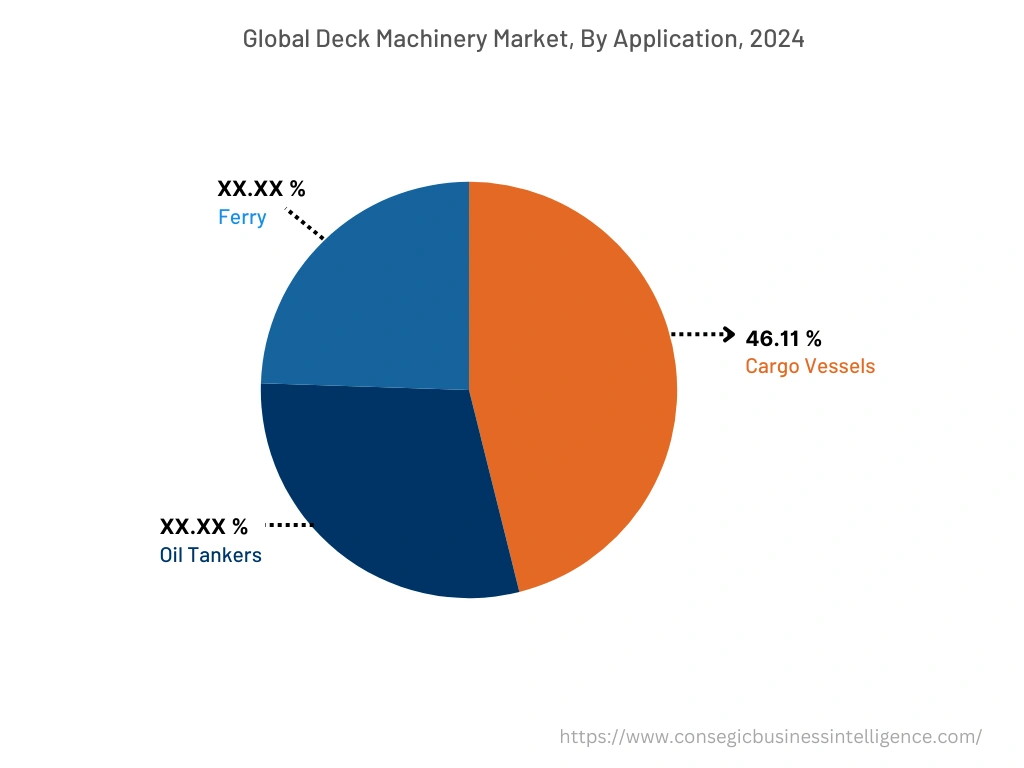
Based on the Region :
The regional segment includes North America, Europe, Asia Pacific, Middle East and Africa, and Latin America.
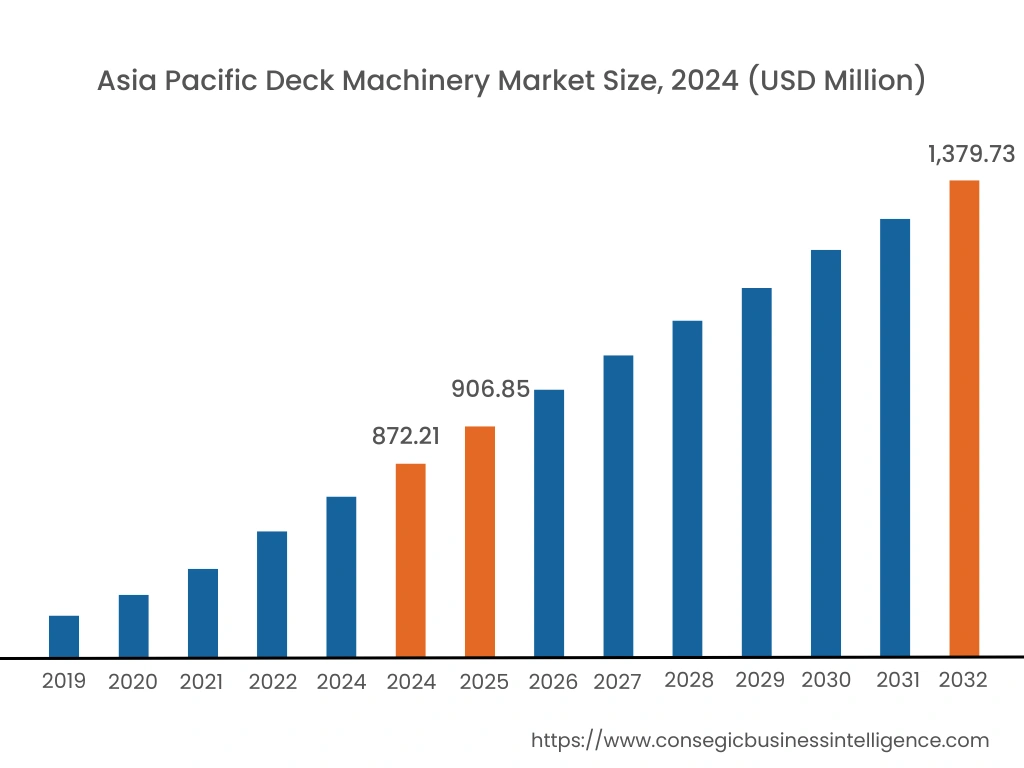
Asia-Pacific region accounted for the largest revenue share in the year 2024 valued at USD 872.21 million and is projected to grow at a CAGR of 5.90% during the forecast period. In addition, in the region, China accounted for the maximum deck machinery market share of 26.1% during 2024. According to the analysis, the rising marine trade in Asia-Pacific region is driving the rise of deck machinery market. According to the analysis and Review of Maritime Transport 2022, Asia emerged as the world's leader in maritime cargo handling center in 2021, accounting for 42% of exports and 64% of imports. Moreover, based on the deck machinery market analysis the rise of domestic ship building in China is driving the deck machinery market demand and trend in the regional market.
North America is anticipated to witness the fastest CAGR of 5.8% during the forecast period. The shipbuilding industry is growing in North America due to the rise in maritime transportation in the region. The demand and trend for machinery such as winches, windlasses, and mooring systems is rising as a result of increasing construction of passenger, cargo, and naval vessels. Furthermore, as per the analysis the increasing demand for commercial and leisure ships as a result of the growing tourism industry is propelling the deck machinery market trend in the region.
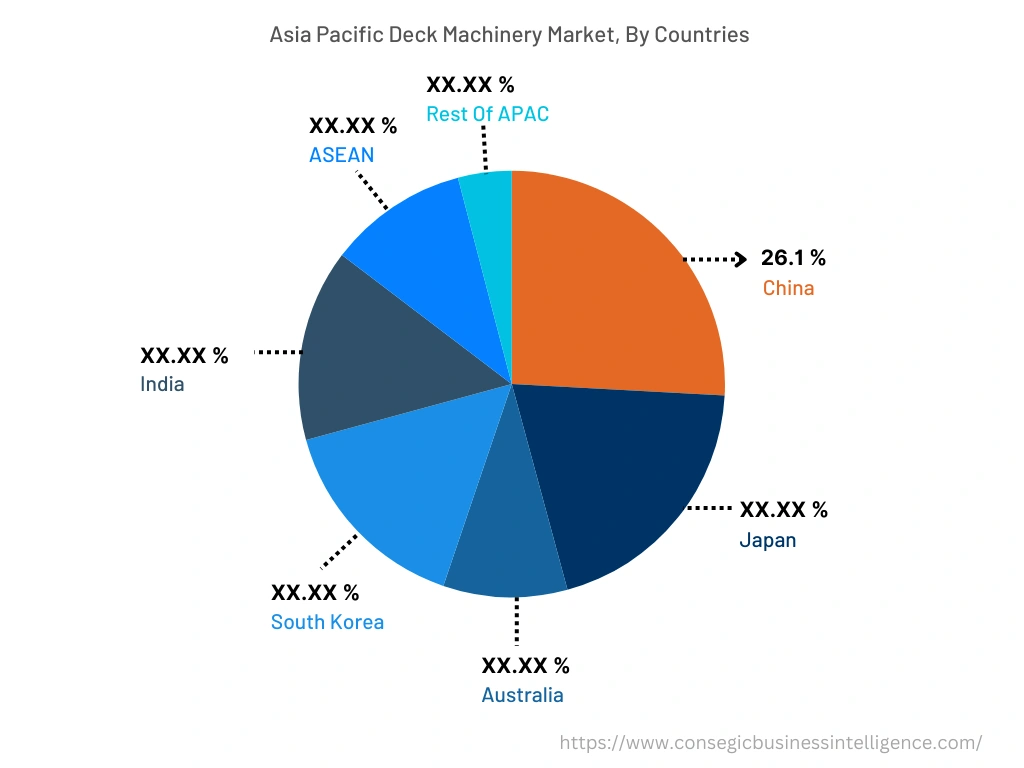
Competitive Analysis & Market Share Insights :
The deck machinery market is highly competitive with major players providing deck machinery such as anchoring systems, winches, windlass, and capstans to the national and international markets. Furthermore, the surge in product innovation, research and development (R&D), and various business strategies, and application launches have accelerated the rise of the deck machinery market trends. Key players in the deck machinery market include-
- Funz San Industry
- MacGregor
- Marine Equipment Pellegrini
- PALFINGER AG
- PaR Systems
- Kawasaki Heavy Industries
- Rapp Marine
- Towimor
- TTS Group ASA
- Wartsila
Recent Industry Developments :
- In August 2022, Liebherr launched new electric heavy lift 800 tonnes ship crane for lifting heavy components in the offshore wind industry.
- In August 2020, Hili Company launched ship-to-shore crane with a lifting capacity of 45t under spreader to increase the capacity and enhancing cargo-handling efficiency.
Key Questions Answered in the Report
What is Deck Machinery? +
Deck machinery comprises of heavy machines that are used in the marine industry for safe and efficient sailing of ships. Machinery such as anchors, winches, and capstans allows ships to withstand harsh environmental conditions.
What specific segmentation details are covered in the Deck Machinery market report, and how is the dominating segment impacting the market growth? +
The report consists of segments including system, product type, and application. Each segment has key dominating sub-segment being driven by the industry trends and market dynamics. For instance, by product type has witnessed winches as the dominating segment in the year 2024, due to its ability to carry heavy loads in cargo transportation.
What specific segmentation details are covered in the Deck Machinery market report, and how is the fastest segment anticipated to impact the market growth? +
The report consists of segments including system, product type, and application. Each segment is projected to have the fastest growing sub-segment being fueled by industry trends and drivers. For instance, by system segment has witnessed electric as the fastest-growing segment during the forecast period due to its zero-emission, lesser noise, and lower response time.
Which region/country is anticipated to witness the highest CAGR during the forecast period, 2025-2032? +
North America is expected to register fastest CAGR growth during the forecast period due to the increasing demand for commercial and leisure ships due to the growing tourism industry.
